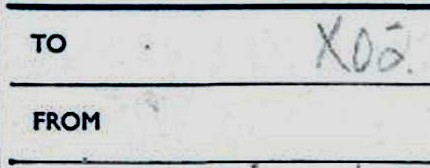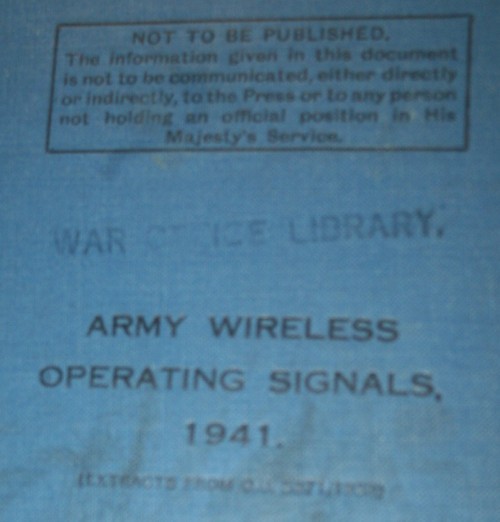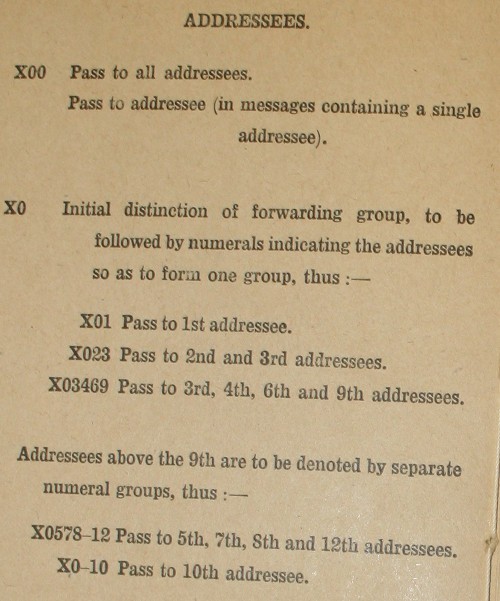The WW2 cipher pigeon message we’ve been trying to crack is addressed to “X02″… which is what, exactly?
Speculation in the initial Daily Mail article was that X02 was a code denoting RAF Bomber Command in High Wycombe. However, against that notion runs the facts that (a) the message was written on an Army Pigeon Message pad, (b) the message was inside a red-coloured (probably British Army) canister, and (c) the British Army enciphered much of its communications.
The problem here is that even though this “Bomber Command” suggestion is therefore fairly threadbare, nobody has yet come up with any properly credible alternatives. It appeared to be yet another aspect of the message that was destined to stay mysterious.
But now I can reveal what X02 actually means.
If you spend the day in the archives at the Royal Signals Museum in Blandford Forum, Dorset (as Stu Rutter and I did yesterday), you might just happen to ask their very helpful archivist if the museum’s archives contains any boxes on codes and ciphers cyphers. And you might then just happen to find at the bottom of one of the two boxes of files a small blue handbook:-
This booklet briefly describes a selection of common “X-codes” used in signalling, most of which are made up of “X” followed by three digits. (There is also a large set of three-letter Q-codes and a large set of three-letter Z-codes.)
However, there’s one very specific exception to the three-digit X-code layout: and that is for codes beginning with “X0”, which are specifically to do with addressees:-
Hence “X0234” would mean “pass to the 2nd, 3rd, and 4th addressees”. In the case of our pigeon message, “X02” simply means “pass to the 2nd addressee“. Which would strongly imply that the (already very short) ciphertext includes at least two addressees. (It was perfectly normal Army practice to include addressees inside ciphertexts: an encrypted address / addressee was known as a codress, while an encrypted address that was concealed within a message (rather than in a consistent place) was known as a “buried codress”.)
And that’s basically it: the mystery of the X02 solved.
OK, I’m sorry Stu & I weren’t yet able to crack the rest of our cipher pigeon’s message, but rest assured we’re hot on its trail… 🙂




And there you have it! The ultimate “wireless” delivery system: Pigeons! Whoooo!
Nick
On a scale of -10 to +10, how interested would you be in serving as ‘peer reviewer’ for a Voynich book?
theoretically..
D
About the addressee system – well done, you!
Diane: a tricky question – if it was a book that primarily went from actual facts to ideas, then +10 (because any problems should be fixable through peer review), but if it was a book that primarily went from ideas to supposed facts, then -10 (because peer review would almost certainly yield no benefit).
Yes, though interpretation of verifiable items – these last as definition of ‘fact’ – can be accurate or otherwise, can’t it.
As if you took a map as a notional or ideal form. Read rightly, it will lead to the monument marked on it – validating itself and the reading.
Read wrongly, it may lead to nothing (or indeed there may be nothing left anyway).
So does that mean the map itself is a fantasy?
I don’t believe by starting from ideas myself; people so easily shift from a spirit of enquiry to one of Eccles-like possession and then resist alternative information because they are desperately in love with their own creation.
However – this matter of interpretation is what a peer reviewer would comment on, isn’t it?
In your case, it would also allow you to annotate where precedence is due to you either here or in your blog, or to anyone else – something you’d be more likely to with some integrity imo.
Speaking of interpretation of a factual object to create an ideal reality – I see Elmar has recently announced his conversion to the ‘faux book’ theory, just as I’ve located a twelfth century precedent for style used in the Voynich botanical section.
Life…Voynich…coffee…(something stronger).
😀
Nick,
About the XO2. I can’t but go along with the Army Wireless publication of 1941, but I did wonder… if the dead-pigeon cipher contains two addressees, and the first one does not get to see the message… what really is the point of having him/her there? Any ideas?
Denis: probably nothing more than the niceties of Army protocol! 🙂 In general, I try not to get caught up with theorizing about the content of cipher mysteries, simply because dealing clearheadedly with what we’ve actually got is usually more than hard enough!
Nick,
OK and thanks. So, no theorizing, but still on the dead-pigeon cipher, may I ask if you have come across any actual messages that were sent by the army during WW2 (in plain text) that might give a glimpse into the type of language used. I wonder e.g. how heavily abbreviated it was, or how chatty and informal? Never having found any ‘real’ secret messages online or elsewhere I have no real idea about this (I no longer live in the UK).
One reason seeing a few messages would help (me) is that frequency tables show words like “the” at their top end, yet words like “the” are the very first to go when one writes in an abbreviated style.
Just on the look out for a few crumbs… ;o)
Denis: unfortunately, the answer is “it depends”. While many messages used technical abbreviations (Q-codes, Z-codes, etc) for brevity and speed, others were a little more chatty. Codenames were also often used for places or people: there were additional map reference codes that were used to conceal coordinates.
In this pigeony instance, a very brief message containing two codresses is likely to be extremely terse. The presence of “X02” probably confirms that a Royal Signals signalman had a hand in the message, so we can probably expect technical abbreviations.
I was just wondering, has anyone explored the possibility the name could be W Sleet or W Steel? He may just have a flourish to his handwriting (as indicated by the T on the SGT/SJT, which means one of the letters could be an l. In addition, the “O” is not fully closed at the top, which could indicate it is not an O at all, but perhaps something else, eg two Es.
http://chris-intel-corner.blogspot.com/2013/10/soe-cryptosystems-german-view.html
This post from October 2013 has a few well considered thoughts about the pigeon cipher, the British SOE, and WOK and LOP ciphers.
Nick,
i read now a lot about the pigeon cipher and collected a lot of names, links, explanations, pictures and so on. But I still could not find an answer to the following question: Why should the sender write the two identifiers (numbers) of the two pigeons he used to send a message on the document? Was it usual to write the identifier of the pigeon on the message? Or is it more or less a hint that the message only can be decoded if both messages arrive?
I have been looking at the PIGEON CIPHER. Here is what I have came up with so far. ” AOAKN ” = CUPPA, ” RQXSR ” = TRYST, ” PABUZ ” = BIONT, ” NLXKG ” = BAYOU, ” UAOTA ” = UPPER, ” LKXGH ” = UNCOY, ” KLOTS ” = SCRUB, ” HVPKD ” = VROUW, ” DJHFP ” = WIGHT, ” WYYNP ” = ABACA, ” MEMKK ” = NAPPA, ” RBQRH ” = TRUTH, ” RGGHT ” = COLOR, ” GQIRU ” = DOUBT, ” FNFJU ” = BATTY, ” GOVFN ” = OCTAV, ” CMPNW ” = BATIK, ” ONNIB ” = COACT, ” DJOFM ” = PEWIT, ” JRZCQ ” = QUBIT, ” AOAKN ” = CUPPA, ” YIDDC ” = UMAMI, ” MIAPX ” = PYOID, ” HORZH ” = THIGH, ” AKEEQ ” = QUEEN, ” TRZEH ” = RELIC, ” FNKTQ ” = QUART . I have entered these by column order. I believe that they should be read by row order, as ” AOAKN ” should be both the starting and ending code entry.